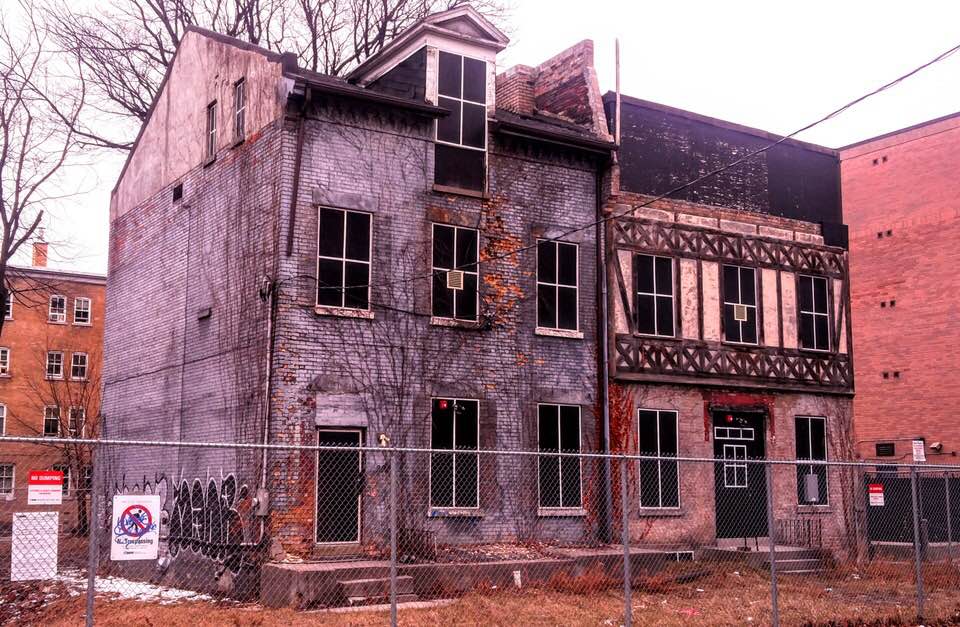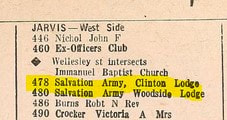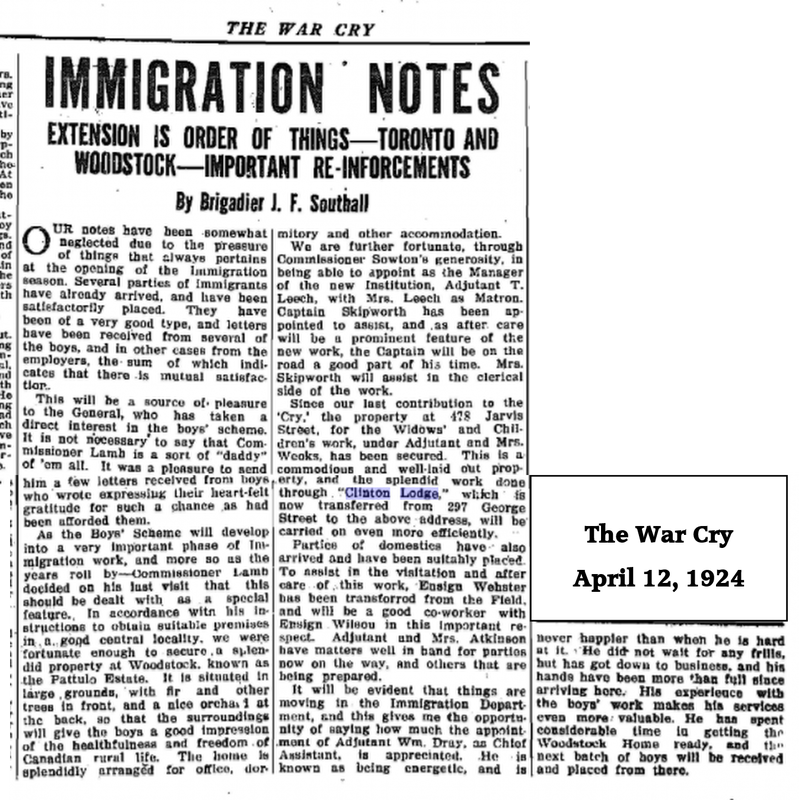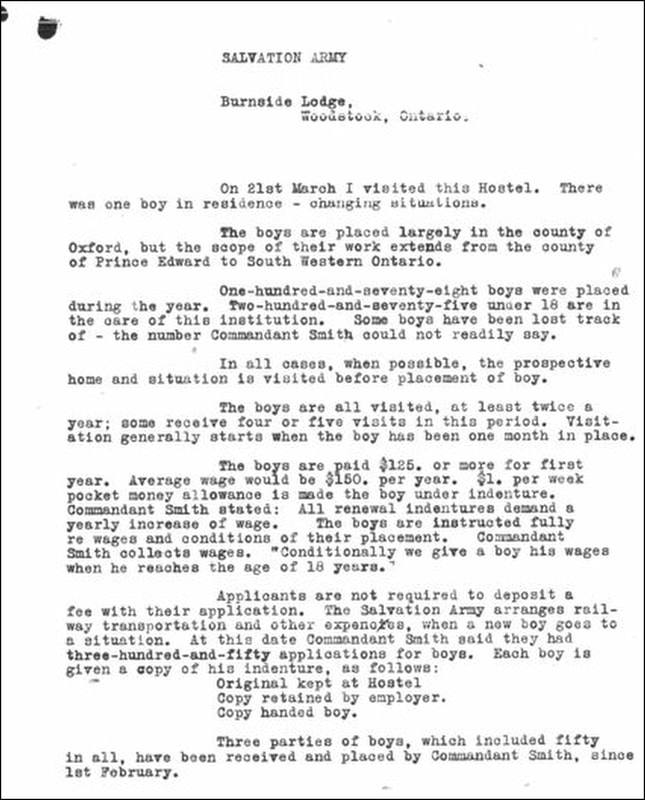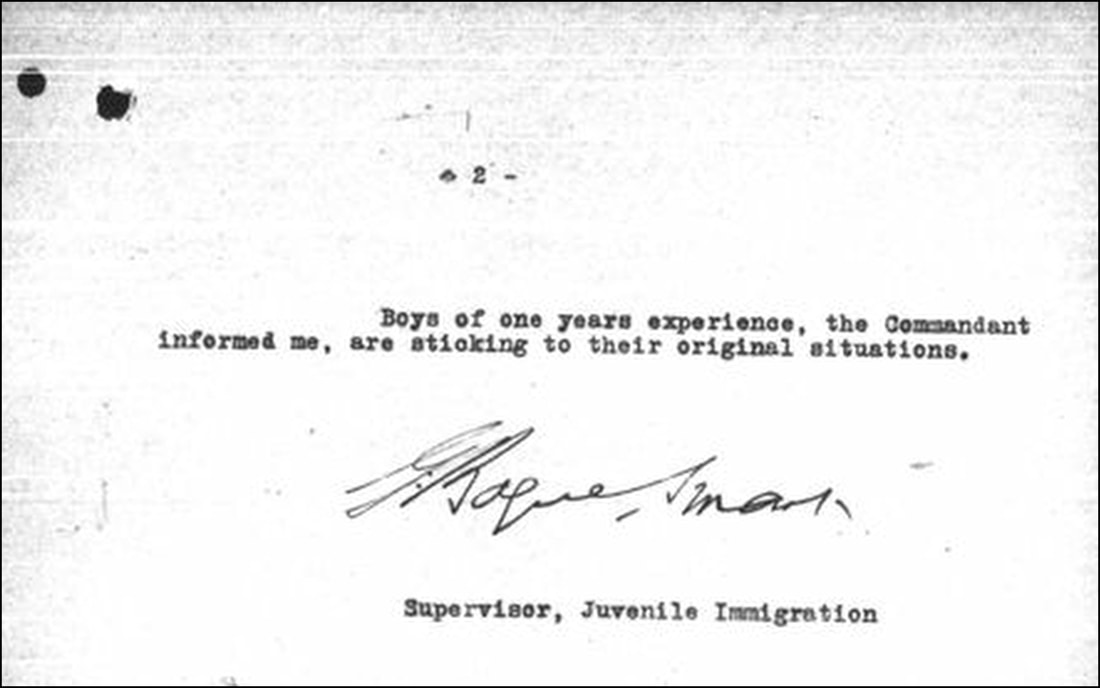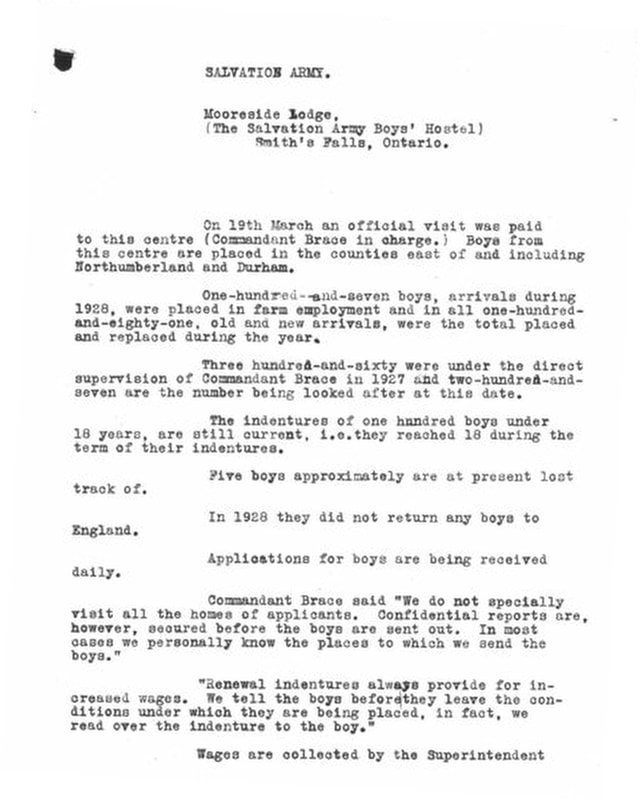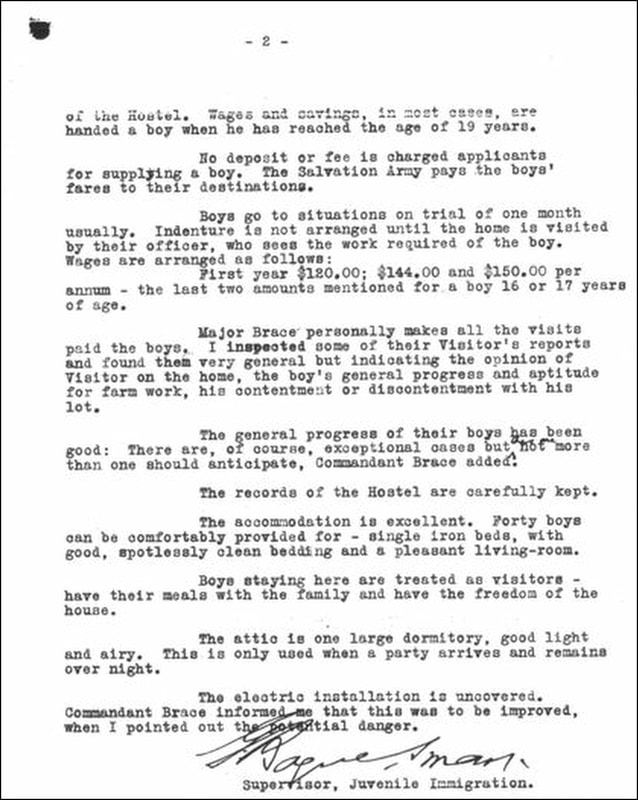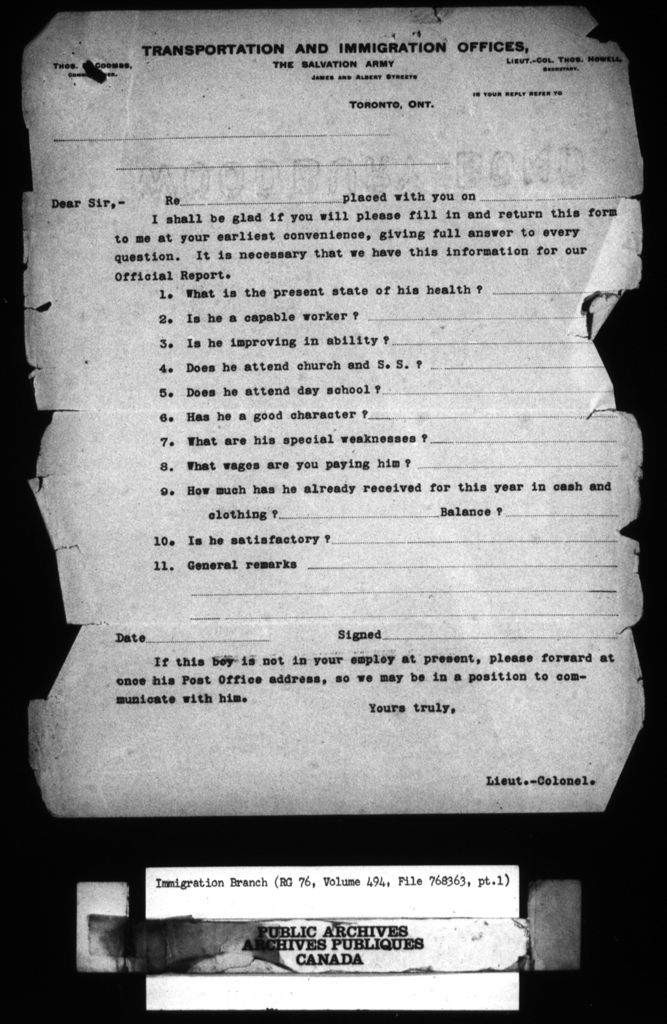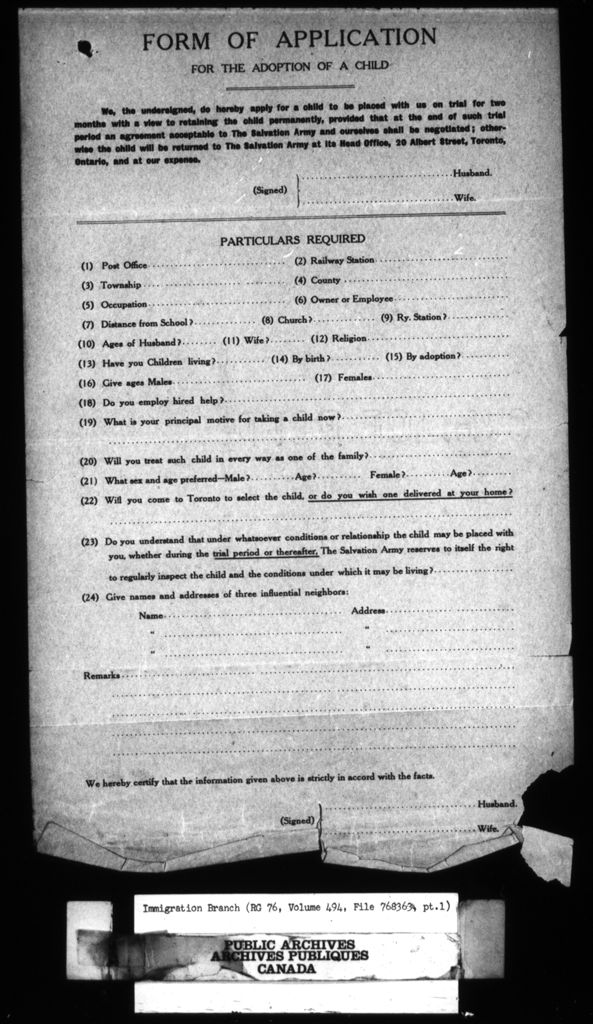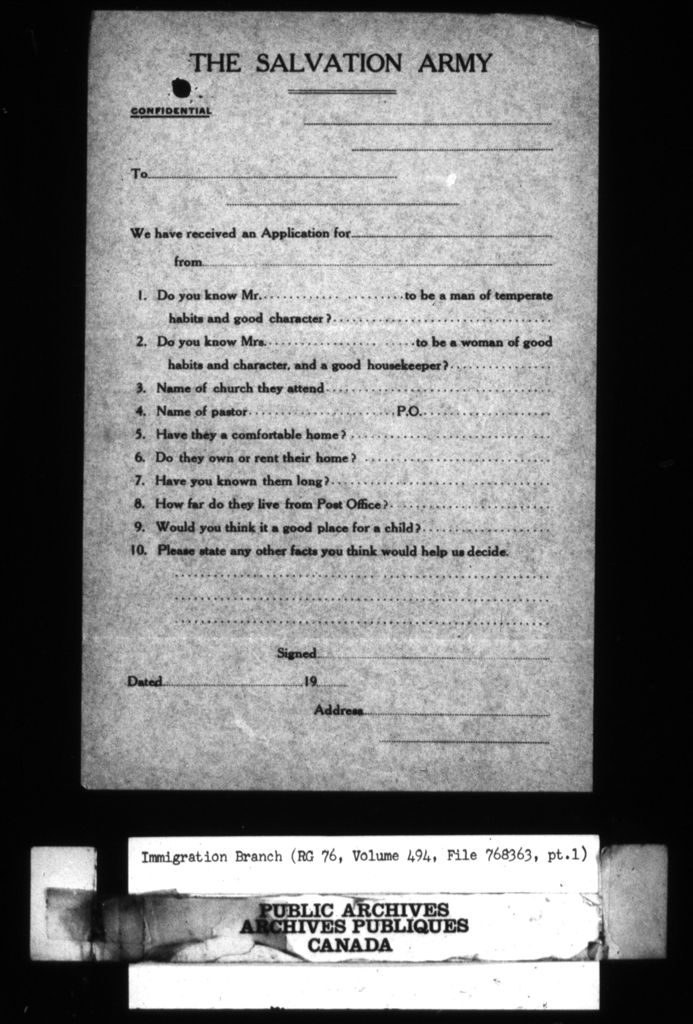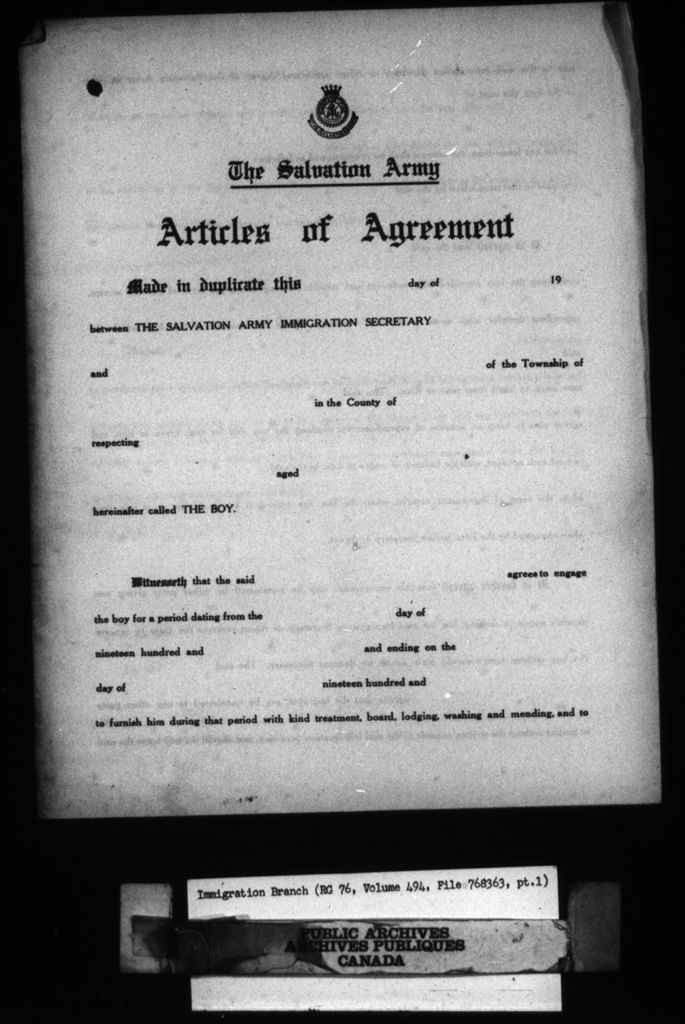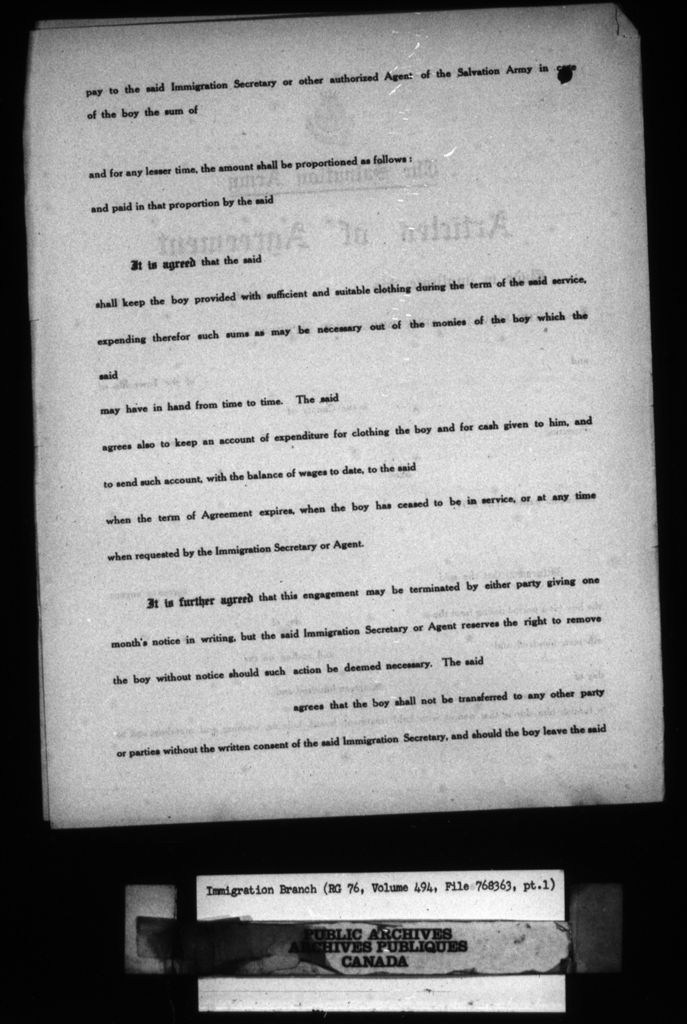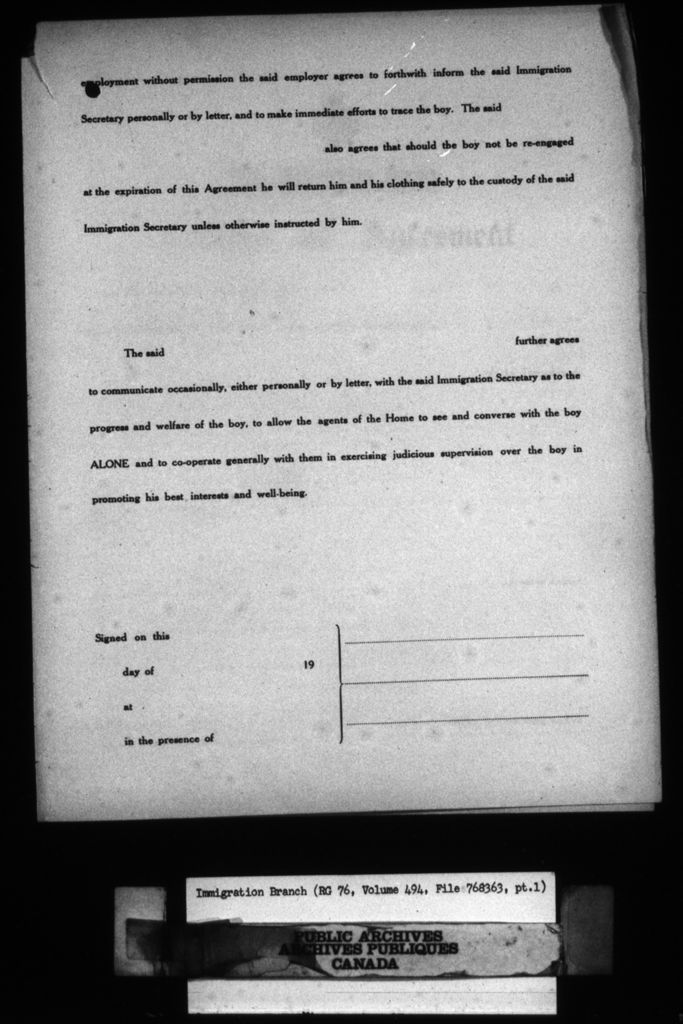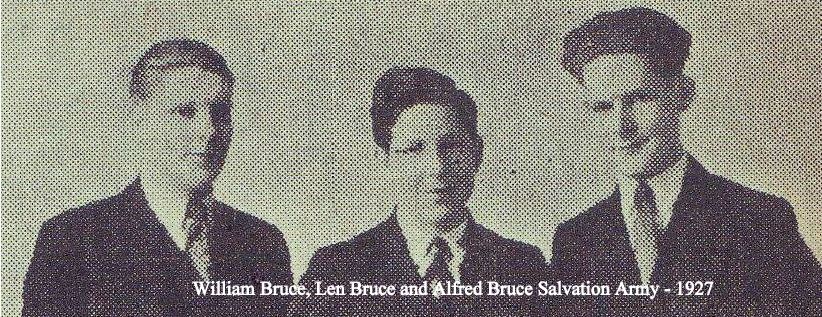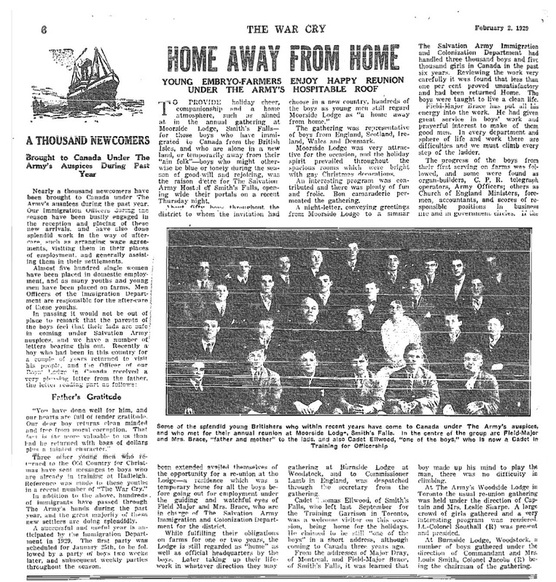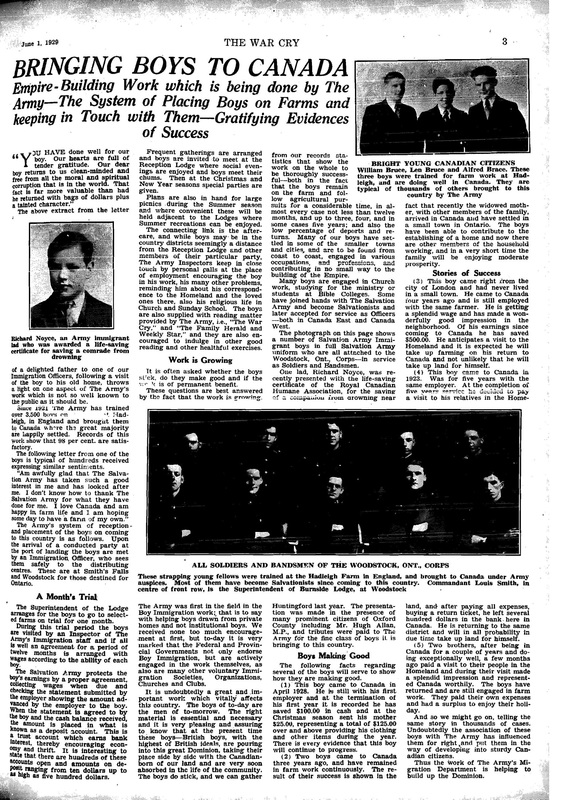The Salvation Army
Burnside Lodge - Woodstock
Mooreside Lodge - Smith Falls
Clinton Lodge - Toronto, Ontario
In Darkest England & the way out
by General Booth
online book
The Salvation Army from 1908 to 1917
This sheet was composed by Alison Williams:
Spreadsheet explanation
Institution is the where the child was from - usually a Poor Law Union. Details of the exact place/home are in the Remarks column.
Form B? column is whether there was a Form B (for workhouse and Industrial School children) in the files; Form A was for children from private homes and philanthropic institutions (who had not previously been in a workhouse). A $2 bonus was paid for children with a Form A, nothing was paid for those with a Form B
Spreadsheet explanation
Institution is the where the child was from - usually a Poor Law Union. Details of the exact place/home are in the Remarks column.
Form B? column is whether there was a Form B (for workhouse and Industrial School children) in the files; Form A was for children from private homes and philanthropic institutions (who had not previously been in a workhouse). A $2 bonus was paid for children with a Form A, nothing was paid for those with a Form B
Your browser does not support viewing this document. Click here to download the document.
[There is no date, but from where it is located on the microfilm, the likely date is early 1929] the text of a memo we found on the microfilm loaned by the National Archives "Salvation Army" "Burnside Lodge, Woodstock, Ontario"
"On 21st March I visited this Hostel. There was one boy in residence -changing situations." "The boys are placed largely in the county of Oxford, but the scope of their work extends from the county of Prince Edward to South Western Ontario."
"One -hundred-and-sevety-eight boys were placed during the year. Two-hundred-and-seventy five under 18 are in the care of this institution. Some boys have been lost track of - the number Commandant Smith could not readily say."
"In all cases, when possible, the prospective home and situation is visited before placement of the boy.""The boys are all visited, at least twice a year; some receive four or five visits in this period. Visitation generally starts when the boy has been one month in place."
"The boys are paid $125. or more for first year. Average wage would be $150. per year. $1. per week pocket money allowance is made the boy under indenture. Commandant smith stated: All renewal indentures demand a yearly increase of wage. The boys are instructed fully re wages and conditions of their placement. Commandant Smith collects wages. "Conditionally we give a boy his wages when he reaches the age of 18 years."
"Applicants are not required to deposit a fee with their application. The Salvation Army arranges railway transportation and other expences [sic] when a new boy goes to a situation. At this date Commandant Smith said they had three-hundred-and-fifty applications for boys. Each boy is given a copy of his indenture, as follows:"
"Original kept at Hostel.
Copy retained by employer.
Copy handed boy."
"Three parties of boys, which included fifty in all, have been received and placed by Commandant Smith, since 1st February." "Boys of one year's experience, the commandent informed me, are sticking to their original situations."
Source for above RootsWeb
"On 21st March I visited this Hostel. There was one boy in residence -changing situations." "The boys are placed largely in the county of Oxford, but the scope of their work extends from the county of Prince Edward to South Western Ontario."
"One -hundred-and-sevety-eight boys were placed during the year. Two-hundred-and-seventy five under 18 are in the care of this institution. Some boys have been lost track of - the number Commandant Smith could not readily say."
"In all cases, when possible, the prospective home and situation is visited before placement of the boy.""The boys are all visited, at least twice a year; some receive four or five visits in this period. Visitation generally starts when the boy has been one month in place."
"The boys are paid $125. or more for first year. Average wage would be $150. per year. $1. per week pocket money allowance is made the boy under indenture. Commandant smith stated: All renewal indentures demand a yearly increase of wage. The boys are instructed fully re wages and conditions of their placement. Commandant Smith collects wages. "Conditionally we give a boy his wages when he reaches the age of 18 years."
"Applicants are not required to deposit a fee with their application. The Salvation Army arranges railway transportation and other expences [sic] when a new boy goes to a situation. At this date Commandant Smith said they had three-hundred-and-fifty applications for boys. Each boy is given a copy of his indenture, as follows:"
"Original kept at Hostel.
Copy retained by employer.
Copy handed boy."
"Three parties of boys, which included fifty in all, have been received and placed by Commandant Smith, since 1st February." "Boys of one year's experience, the commandent informed me, are sticking to their original situations."
Source for above RootsWeb
Burnside Lodge, Woodstock, Ontario
conditions upon placement of boys 1929
source: Ontario Arcives and Canadiana.ca
| oocihm.lac_reel_c10429_data_sip_data_files_0077.jpg.jpg | |
| File Size: | 1422 kb |
| File Type: | jpg |
Salvation Army - Smith Falls - Conditions upon placement of boys
|
| ||||||||||||
Salvation Army placement lists from Heritage.ca c1923-1930
http://heritage.canadiana.ca/view/oocihm.lac_reel_c10429/94?r=0&s=1
http://heritage.canadiana.ca/view/oocihm.lac_reel_c10429/107?r=0&s=1
http://heritage.canadiana.ca/view/oocihm.lac_reel_c10429/157?r=0&s=1
http://heritage.canadiana.ca/view/oocihm.lac_reel_c10429/158?r=0&s=1
http://heritage.canadiana.ca/view/oocihm.lac_reel_c10429/273?r=0&s=1
http://heritage.canadiana.ca/view/oocihm.lac_reel_c10429/274?r=0&s=1
http://heritage.canadiana.ca/view/oocihm.lac_reel_c10429/107?r=0&s=1
http://heritage.canadiana.ca/view/oocihm.lac_reel_c10429/157?r=0&s=1
http://heritage.canadiana.ca/view/oocihm.lac_reel_c10429/158?r=0&s=1
http://heritage.canadiana.ca/view/oocihm.lac_reel_c10429/273?r=0&s=1
http://heritage.canadiana.ca/view/oocihm.lac_reel_c10429/274?r=0&s=1
Page 1 Avery, Wallace placed with Mr R. W. Rodgers Crawford , William placed with Mr N. W. Fuller Harris, Andrew placed with Mr G. Erskine Robertson Harris, William placed with Mr John H. Nesbitt Heinman, John placed with Mr G. H. ?ridekirk (Bridekirk?) Holmes, William placed with Mr Harmer Emmerton Hounsell, Roy placed with Mr Jesse F. Skinner Kidd, Donald placed with Mr Cyrus D. Eastman Lazarod, Maurice placed with Mr Elam Roth Levell, Arthur placed with Mr Alfred E. Merrill Mason, James placed with Mr Thomas V. Ridley McLeod, Henry placed with Mr Robert MacKie Nicol, Thomas placed with Mr Lyman H. Mc Allister Parsons, Henry placed with Mr Wesley J. Kernchan Patterson, William placed with Mr Percy A. Priest Raeside, George placed with Mr Lloyd Hewitt St Ruth, John placed with Mr Frank B. Percy Slater, Alfred placed with Mr James W. Milligan Smith, William placed with Mr Burton W. Hayes Stott, Charles placed with Mr Charles W. Heatherington Thornley, Joseph placed with Mr Charles R. Richardson Wake, William placed with Mr Fred A. Spicer Watson, Robert placed with Mr J. Victor Armstrong Willey, Reginald placed with Mr J. T. Kelly Wilson, David placed with Mr Sidney G. Skinner Wood, Thomas placed with Mr Clarence Birchmore
Page 2 Attis (?) Frank placed with Mr Leslie McDonald Chettlege (?) , Arthur placed with Mr Natry (?) Cole Collard, John placed with Mr G. Eric Mattle Daniels, Thomas placed with Mr Hugh A. Fletcher Foster, Frederick placed with Mr Robert Fletcher Hughes, D?? placed with Mr Leonard Sutherland Harris, Jat… placed with Mr J…. Ellis Humphrey, Percy placed with Mr John ? Munro Langdon, Fred placed with Mr D. W. Fletcher Lewis, John placed with Mr William N. ??? Mell... , Philip placed with Mr J. A, Latte Munro (?), Thomas (?) placed with Mr ?. L. Heed Pas…., Edward placed with Mr Clifford ? Bailey Smith, Neritt placed with Mr Walter M. Barton(?) Tough, George placed with Mr George Oats Thompson, Arthur placed with Mr G. G. ...sle(?) Edward, Taylor placed with Mr Fred A. Spicer Solpace, Lewis placed with Mr J. N. Earl NAME
Page 3 Sommerville, Charles placed with Mr Chester Ryan Thomson, Robert placed with Mr Dougal McPherson Woolf, Eric placed with Mr Duncan McTavish
Page 4 Bell, Angus placed with Mr B. Rowcliffe Berley, Thomas placed with Mr Ross Hammond McClusky, Edward placed with Mr D. Fletcher Cowley, Charles placed with Mr J. Booth Charlton, James placed with Mr Horace Hague Carpenter, Charles placed with Mr Charles Waring Cooper, George placed with Mr N. Clarke Draffen, William placed with Mr Cyril Hinge Mc Ewan, James placed with Mr C. Herbison Greer, Robert placed with Mr Edward Meredith Hetherington, William placed with Mr Leo Craig McIntyre, James placed with Mr James Workman Moss, Benjamin placed with Mr McVicar Mezzio (Muzzio), Frederick placed with Mr David Thom Moore, Frederick placed with Mr E. A. Clifford Marshall, Nathan placed with Mr George Hardie Maddock, Phillip placed with Mr Donald Fraser Oliver, Arthur placed with Mr Percy Core Posner, Leonard placed with Mr William Kloah Rose, Leslie placed with Mr Nelson Kerr Sanger, Arthur placed with Mr Edgar Robb
Page 5 Anderson, Dennis placed with Mr James Robb Betts, Ronald placed with Mr Lionel Kemp Butt, William placed with Mr Maitland Foster Binstead, Alfred placed with Mr Thomas Meredith Britten, Aubrey placed with Mr W. Jackson Britten , Thomas placed with Mr J. Cartnell Carr, Cecil placed with Mr William Butler Cruikshanks, Archibald placed with Mr Frank Garfat Clough, William placed with Mr C. H. Hughes Felvus, James placed with Mr S. M. Atherton Huddlestone, Bramwell placed with Mr L. Stower Haring, Kenneth placed with Mr Nelson Green Hill, Thomas placed with Mr ? Quinn Ingle, Fred placed with Mr L.? A Hammodd King, Edward placed with Mr Wallace Gardner Lawson, James placed with Mr Christian Jacomson(?) Meller, Phillip placed with Mr D. Ferguson Murray, William placed with Mr F. H. Chanter Nicholl, William placed with Mr George Kelly Noyce, Reginald placed with Mr Walter Hewitt McNeil, William placed with Mr ? Swanwick Nelson, Wilfred placed with Mr A. Zink
PAGE 6 Price , Nrychan ? placed with Mr Cecil Evans McQuarrie, Liege placed with Mr R. Quinn Robinson, Stephen placed with Mr Dugald McVicar Ryan, Joseph placed with Mr Clayton Arthur So?nenschein, Charles placed with Mr S. H. Coneybeare Smith, Edward placed with Mr James Gordon Taylor , David placed with Mr William Harper Tennant , Henry placed with Mr Kenneth Munroe Wagland, George placed with Mr O. T. Rosebrugh
Domestic servants Nostard, Evelyn placed with Mrs Fieder -Toronto Tepp, Elizabeth placed with Mrs Nuycke (?)- Toronto
Page 2 Attis (?) Frank placed with Mr Leslie McDonald Chettlege (?) , Arthur placed with Mr Natry (?) Cole Collard, John placed with Mr G. Eric Mattle Daniels, Thomas placed with Mr Hugh A. Fletcher Foster, Frederick placed with Mr Robert Fletcher Hughes, D?? placed with Mr Leonard Sutherland Harris, Jat… placed with Mr J…. Ellis Humphrey, Percy placed with Mr John ? Munro Langdon, Fred placed with Mr D. W. Fletcher Lewis, John placed with Mr William N. ??? Mell... , Philip placed with Mr J. A, Latte Munro (?), Thomas (?) placed with Mr ?. L. Heed Pas…., Edward placed with Mr Clifford ? Bailey Smith, Neritt placed with Mr Walter M. Barton(?) Tough, George placed with Mr George Oats Thompson, Arthur placed with Mr G. G. ...sle(?) Edward, Taylor placed with Mr Fred A. Spicer Solpace, Lewis placed with Mr J. N. Earl NAME
Page 3 Sommerville, Charles placed with Mr Chester Ryan Thomson, Robert placed with Mr Dougal McPherson Woolf, Eric placed with Mr Duncan McTavish
Page 4 Bell, Angus placed with Mr B. Rowcliffe Berley, Thomas placed with Mr Ross Hammond McClusky, Edward placed with Mr D. Fletcher Cowley, Charles placed with Mr J. Booth Charlton, James placed with Mr Horace Hague Carpenter, Charles placed with Mr Charles Waring Cooper, George placed with Mr N. Clarke Draffen, William placed with Mr Cyril Hinge Mc Ewan, James placed with Mr C. Herbison Greer, Robert placed with Mr Edward Meredith Hetherington, William placed with Mr Leo Craig McIntyre, James placed with Mr James Workman Moss, Benjamin placed with Mr McVicar Mezzio (Muzzio), Frederick placed with Mr David Thom Moore, Frederick placed with Mr E. A. Clifford Marshall, Nathan placed with Mr George Hardie Maddock, Phillip placed with Mr Donald Fraser Oliver, Arthur placed with Mr Percy Core Posner, Leonard placed with Mr William Kloah Rose, Leslie placed with Mr Nelson Kerr Sanger, Arthur placed with Mr Edgar Robb
Page 5 Anderson, Dennis placed with Mr James Robb Betts, Ronald placed with Mr Lionel Kemp Butt, William placed with Mr Maitland Foster Binstead, Alfred placed with Mr Thomas Meredith Britten, Aubrey placed with Mr W. Jackson Britten , Thomas placed with Mr J. Cartnell Carr, Cecil placed with Mr William Butler Cruikshanks, Archibald placed with Mr Frank Garfat Clough, William placed with Mr C. H. Hughes Felvus, James placed with Mr S. M. Atherton Huddlestone, Bramwell placed with Mr L. Stower Haring, Kenneth placed with Mr Nelson Green Hill, Thomas placed with Mr ? Quinn Ingle, Fred placed with Mr L.? A Hammodd King, Edward placed with Mr Wallace Gardner Lawson, James placed with Mr Christian Jacomson(?) Meller, Phillip placed with Mr D. Ferguson Murray, William placed with Mr F. H. Chanter Nicholl, William placed with Mr George Kelly Noyce, Reginald placed with Mr Walter Hewitt McNeil, William placed with Mr ? Swanwick Nelson, Wilfred placed with Mr A. Zink
PAGE 6 Price , Nrychan ? placed with Mr Cecil Evans McQuarrie, Liege placed with Mr R. Quinn Robinson, Stephen placed with Mr Dugald McVicar Ryan, Joseph placed with Mr Clayton Arthur So?nenschein, Charles placed with Mr S. H. Coneybeare Smith, Edward placed with Mr James Gordon Taylor , David placed with Mr William Harper Tennant , Henry placed with Mr Kenneth Munroe Wagland, George placed with Mr O. T. Rosebrugh
Domestic servants Nostard, Evelyn placed with Mrs Fieder -Toronto Tepp, Elizabeth placed with Mrs Nuycke (?)- Toronto
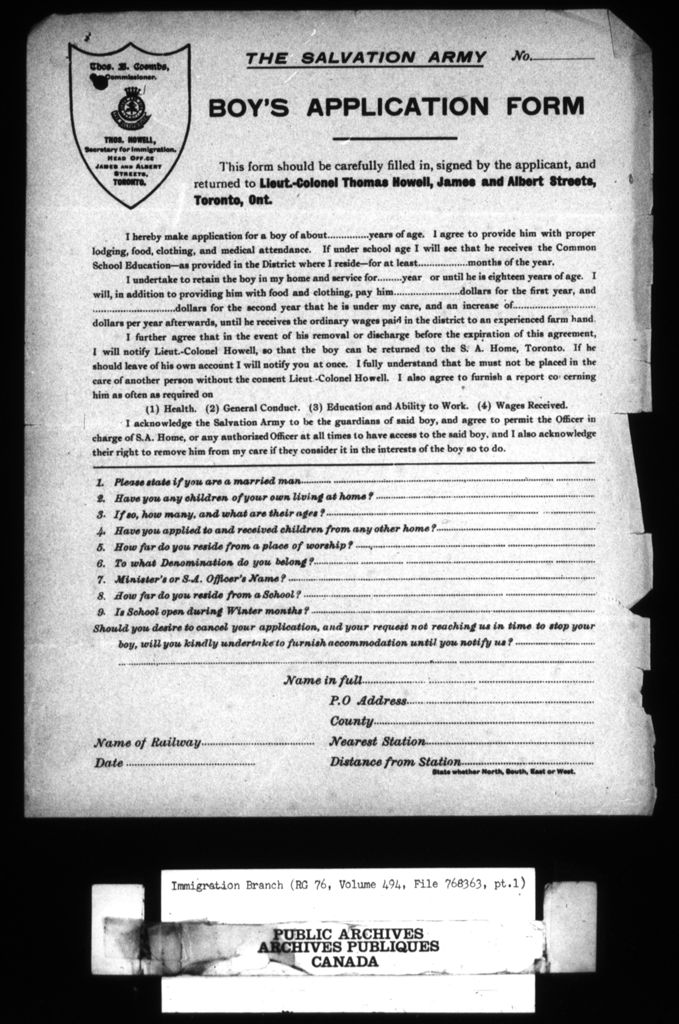
Woodstock Public Library Newspaper Archives re: Burnside Lodge
references to Burnside Lodge
All Soldiers And Bandsmen Of The Woodstock, Ont. Corps: These strapping young fellows were trained at the Hadleigh Farm in England, and brought to Canada under Army auspices. Most of them have become Salvationists since coming to this country. Commandant Lois Smith, in centre front row, is the Superintendent of Burnside Lodge, at Woodstock. (Mr. Leonard Bingham; back row, second from left).
William Bruce, Len Bruce, Alfred Bruce
Your browser does not support viewing this document. Click here to download the document.
| The Crest - News and Views of the Salvation Army | |
| File Size: | 1740 kb |
| File Type: | |
Your browser does not support viewing this document. Click here to download the document.
| the_armys_work.pdf | |
| File Size: | 2337 kb |
| File Type: | |
Your browser does not support viewing this document. Click here to download the document.
| general_booth_s_scheme.pdf | |
| File Size: | 3498 kb |
| File Type: | |
Your browser does not support viewing this document. Click here to download the document.
| illustrated_guide_to_sa_land_colony.pdf | |
| File Size: | 14522 kb |
| File Type: | |
From: The War Cry - February 2 1929
Cadet Ellwood,
Your browser does not support viewing this document. Click here to download the document.
Bringing Boys To Canada - the work of the Salvation Army
extracted from "The War Cry - June1929" (available in pdf below)
Richard Noyce, Lewis Smith,
Your browser does not support viewing this document. Click here to download the document.
| the_war_cry_1929.pdf | |
| File Size: | 16942 kb |
| File Type: | |
From "The War Cry" 1929
Bringing Boys To CanadaEmpire-Building Work which is being done by The Army – The System of Placing Boys on farms and keeping in Touch with Them – Gratifying Evidences of Success
“You have done well for our boy. Our hearts are full of tender gratitude. Our dear boy returns to us clean-minded and free from all the moral and spiritual corruption that is in the world. That fact is far more valuable than had he returned with bags of dollars plus a tainted character.”The above extract from the letter of a delighted father to one of our Immigration Officers, following a visit of the boy to his old home, throws a light on one aspect of The Army’s work which is not so well known to the public as it should be.
Since 1921 The Army has trained over 3,500 boys on its farm at Hadleigh, in England, and brought them to Canada where the great majority are happily settled. Records of this work show that 95 per cent are satisfactory.
The following letter from one of the boys is typical of hundreds received expressing similar sentiments.
“Am awfully glad that The Salvation Army has taken such a good interest in me and has looked after me. I don’t know how to thank The Salvation Army for what they have done for me. I love Canada and am happy in farm life and I am hoping some day to have a farm of my own.”The Army’s system of reception and placement of the boys on coming to this country is as follows. Upon the arrival of a conducted party at the port of landing the boys are met by an Immigration Officer, who sees them safely to the distributing centres. These are at Smiths Falls and Woodstock for those destined for Ontario.
A Month’s TrialThe Superintendent of the Lodge arranges for the boys to go to selected farms on trial for one month.
During the trial period the boys are visited by an Inspector of The army’s Immigration staff and if all is well an agreement for a period of twelve months is arranged with wages according to the ability of each boy.
The Salvation Army protects the boy’s earnings by a proper agreement, collecting wages when due and checking the statement submitted by an employer showing the amount advanced by the employer to the boy. When the statement is agreed to by the boy and the cash balance received, the amount is placed in what is known as a deposit account. This is a trust account which earns bank interest, thereby encouraging economy and thrift. It is interesting to state that there are hundreds of these accounts open and amounts on deposit ranging from ten dollars up to as high as five hundred dollars.
Frequent gatherings are arranged and boys are invited to meet at the Reception Lodge where social evenings are enjoyed and boys meet their chums. Then at the Christmas and New Year seasons special parties are given.
Plans are also in hand for large picnics during the Summer season and where convenient these will be adjacent to the Lodges where Summer recreation can be enjoyed.
The connecting link is the after-care, and while boys may be in the country districts seemingly a distance from the Reception Lodge and other members of their particular party, The Army Inspectors keep in close touch by personal calls at the place of employment encouraging the boy in his work, his many other problems, reminding him about his correspondence to the Homeland and the loved ones there, also his religious life in Church and Sunday School. The boys are also supplied with reading matter provided by The Army, i.e. “The War Cry,” and “The Family Herald and Weekly Star,” and they are also encouraged to indulge in other good reading and other healthful exercises.
Work Is Growing It is often asked whether the boys stick, do they make good and if the work is of permanent benefit.
These questions are best answered by the fact that the work is growing. The Army was first in the field in the Boy Immigration work; that is to say with helping boys drawn from private homes and not institutional boys. We received none too much encouragement at first, but to-day it is very marked that the Federal and Provincial Governments not only endorse Boy Immigration, but are actively engaged in the work themselves, as are also many other voluntary Immigration Societies, Organizations, Churches and Clubs.
It is undoubtedly a great and important work which vitally affects this country. The boys of to-day are the men of to-morrow. The right material is essential and necessary and it is very pleasing and assuring to know that at the present time these boys – British boys, with the highest British ideals, are pouring into this great Dominion, taking their place side by side with the Canadian-born of our land and are very soon absorbed in the life of the community.
The boys do stick and we can gather from our records statistics that show the work on the whole to be thoroughly successful – both in the fact that the boys remain on the farm and follow agricultural pursuits for a considerable time, in almost every case not less than twelve months, and up to three, four, and in some cases five years; and also the low percentage of deports and returns. Many of our boys have settled in some of the smaller towns and cities, and are to be found from coast to coast, engaged in various occupations, and professions, and contributing in no small way to the building of the Empire.
Many boys are engaged in Church work, studying for the ministry or students at Bible Colleges. Some of have joined hands with The Salvation army and become Salvationists and later accepted for service as Officers – both in Canada East and Canada West.
The photograph on this page shows a number of Salvation Army Immigrant boys in full Salvation Army uniform who are all attached to the Woodstock, Ont. Corps – in service as Soldiers and Bandsmen.
One lad, Richard Noyce, was recently presented with the life-saving certificate of the Royal Canadian Humane Association, for the saving of a companion from drowning near Huntingford last year. The presentation was made in the presence of many prominent citizens of Oxford County including Mr. Hugh Allan, M.P. and tributes were paid to The Army for the fine class of boys it is bringing to this country.
Boys Making GoodThe following facts regarding several of the boys will serve to show how they are making good.
Stories of Success
Thus the work of The Army’s Immigration Department is helping to build up the Dominion.
“You have done well for our boy. Our hearts are full of tender gratitude. Our dear boy returns to us clean-minded and free from all the moral and spiritual corruption that is in the world. That fact is far more valuable than had he returned with bags of dollars plus a tainted character.”The above extract from the letter of a delighted father to one of our Immigration Officers, following a visit of the boy to his old home, throws a light on one aspect of The Army’s work which is not so well known to the public as it should be.
Since 1921 The Army has trained over 3,500 boys on its farm at Hadleigh, in England, and brought them to Canada where the great majority are happily settled. Records of this work show that 95 per cent are satisfactory.
The following letter from one of the boys is typical of hundreds received expressing similar sentiments.
“Am awfully glad that The Salvation Army has taken such a good interest in me and has looked after me. I don’t know how to thank The Salvation Army for what they have done for me. I love Canada and am happy in farm life and I am hoping some day to have a farm of my own.”The Army’s system of reception and placement of the boys on coming to this country is as follows. Upon the arrival of a conducted party at the port of landing the boys are met by an Immigration Officer, who sees them safely to the distributing centres. These are at Smiths Falls and Woodstock for those destined for Ontario.
A Month’s TrialThe Superintendent of the Lodge arranges for the boys to go to selected farms on trial for one month.
During the trial period the boys are visited by an Inspector of The army’s Immigration staff and if all is well an agreement for a period of twelve months is arranged with wages according to the ability of each boy.
The Salvation Army protects the boy’s earnings by a proper agreement, collecting wages when due and checking the statement submitted by an employer showing the amount advanced by the employer to the boy. When the statement is agreed to by the boy and the cash balance received, the amount is placed in what is known as a deposit account. This is a trust account which earns bank interest, thereby encouraging economy and thrift. It is interesting to state that there are hundreds of these accounts open and amounts on deposit ranging from ten dollars up to as high as five hundred dollars.
Frequent gatherings are arranged and boys are invited to meet at the Reception Lodge where social evenings are enjoyed and boys meet their chums. Then at the Christmas and New Year seasons special parties are given.
Plans are also in hand for large picnics during the Summer season and where convenient these will be adjacent to the Lodges where Summer recreation can be enjoyed.
The connecting link is the after-care, and while boys may be in the country districts seemingly a distance from the Reception Lodge and other members of their particular party, The Army Inspectors keep in close touch by personal calls at the place of employment encouraging the boy in his work, his many other problems, reminding him about his correspondence to the Homeland and the loved ones there, also his religious life in Church and Sunday School. The boys are also supplied with reading matter provided by The Army, i.e. “The War Cry,” and “The Family Herald and Weekly Star,” and they are also encouraged to indulge in other good reading and other healthful exercises.
Work Is Growing It is often asked whether the boys stick, do they make good and if the work is of permanent benefit.
These questions are best answered by the fact that the work is growing. The Army was first in the field in the Boy Immigration work; that is to say with helping boys drawn from private homes and not institutional boys. We received none too much encouragement at first, but to-day it is very marked that the Federal and Provincial Governments not only endorse Boy Immigration, but are actively engaged in the work themselves, as are also many other voluntary Immigration Societies, Organizations, Churches and Clubs.
It is undoubtedly a great and important work which vitally affects this country. The boys of to-day are the men of to-morrow. The right material is essential and necessary and it is very pleasing and assuring to know that at the present time these boys – British boys, with the highest British ideals, are pouring into this great Dominion, taking their place side by side with the Canadian-born of our land and are very soon absorbed in the life of the community.
The boys do stick and we can gather from our records statistics that show the work on the whole to be thoroughly successful – both in the fact that the boys remain on the farm and follow agricultural pursuits for a considerable time, in almost every case not less than twelve months, and up to three, four, and in some cases five years; and also the low percentage of deports and returns. Many of our boys have settled in some of the smaller towns and cities, and are to be found from coast to coast, engaged in various occupations, and professions, and contributing in no small way to the building of the Empire.
Many boys are engaged in Church work, studying for the ministry or students at Bible Colleges. Some of have joined hands with The Salvation army and become Salvationists and later accepted for service as Officers – both in Canada East and Canada West.
The photograph on this page shows a number of Salvation Army Immigrant boys in full Salvation Army uniform who are all attached to the Woodstock, Ont. Corps – in service as Soldiers and Bandsmen.
One lad, Richard Noyce, was recently presented with the life-saving certificate of the Royal Canadian Humane Association, for the saving of a companion from drowning near Huntingford last year. The presentation was made in the presence of many prominent citizens of Oxford County including Mr. Hugh Allan, M.P. and tributes were paid to The Army for the fine class of boys it is bringing to this country.
Boys Making GoodThe following facts regarding several of the boys will serve to show how they are making good.
- (1) This boy came to Canada in April 1928. He is still with his first employer and at the termination of his first year it is recorded he has saved $100.00 in cash and at the Christmas season sent his mother $25.00, representing a total of $125.00 over and above providing his clothing and other items during the year. There is every evidence that this boy will continue to progress.
(2) Two boys came to Canada three years ago and have remained in farm work continuously. The result of their successes is shown in the fact that recently the widowed mother, with other members of the family, arrived in Canada and have settled in a small town in Ontario. The boys have been able to contribute to the establishing of a home and now there are other members of the household working, and in a very short time the family will be enjoying moderate prosperity.
Stories of Success
- (3) This boy came right from the city of London and had never lived in a small town. He came to Canada four years ago and is still employed with the same farmer. He is getting a splendid wage and has made a wonderfully good impression in the neighborhood. Of his earnings since coming to Canada he has saved $500.00, He anticipates a visit to the Homeland and it is expected he will take up farming on his return to Canada and not unlikely that he will take up land for himself.
(4) This boy came to Canada in 1923. Was for five years with the same employer. At the completion of five years service he decided to pay a visit to his relatives in the Homeland, and after paying all expenses, buying a return ticket, he left several hundred dollars in the bank here in Canada. He is returning to the same district and will in all probability in due time take up land for himself.
(5) Two brothers, after being in Canada for a couple of years and doing exceptionally well, a few months ago paid a visit to their people in the Homeland and during their visit made a splendid impression and represented Canada worthily. The boys have returned and are still engaged in farm work. They paid their own expenses and had a surplus to enjoy their holiday.
Thus the work of The Army’s Immigration Department is helping to build up the Dominion.
Getty images have three pictures of boys who came with the Salvation Army arriving on April 14 1923. They can be purchased through their web site at: http://www.gettyimages.ca/detail/news-photo/orphaned-boys-from-the-dr-barnardos-homes-leave-for-a-new-news-photo/148785037
Included in these photos are: Thomas Birch, Harold Chappell, Herbert Chesworth, Edward Claridge, Arthur Clarke, Stanley Cole, Joseph Cook, Joseph Crackness. John Fasching, Frank Garton, Alfred Gregory, Oliver Hill, Jesse Holt, Leonard Humphries, Ernest Jouhard Malcolm McMillan, Walter Morrison, Frederick Neal, John Nelmes, Bernard Pateman, Frederick Peck, Archie Philpot, Leonard Punter, Sidney Purser, Horace Roberts, Albert Rolfe, Frederick Sheperd, William Smith, Kenneth Stebbings, William Todd, Arthur Wright, Hubert Wright.
Included in these photos are: Thomas Birch, Harold Chappell, Herbert Chesworth, Edward Claridge, Arthur Clarke, Stanley Cole, Joseph Cook, Joseph Crackness. John Fasching, Frank Garton, Alfred Gregory, Oliver Hill, Jesse Holt, Leonard Humphries, Ernest Jouhard Malcolm McMillan, Walter Morrison, Frederick Neal, John Nelmes, Bernard Pateman, Frederick Peck, Archie Philpot, Leonard Punter, Sidney Purser, Horace Roberts, Albert Rolfe, Frederick Sheperd, William Smith, Kenneth Stebbings, William Todd, Arthur Wright, Hubert Wright.
